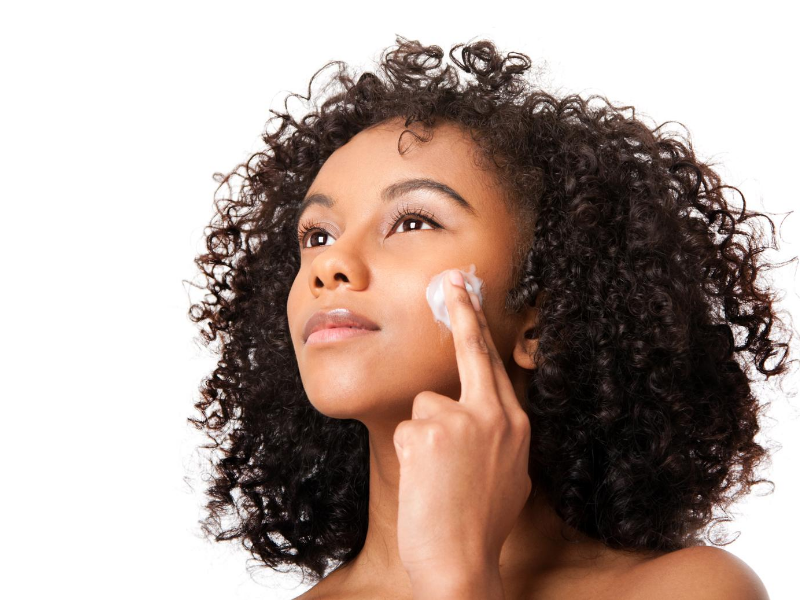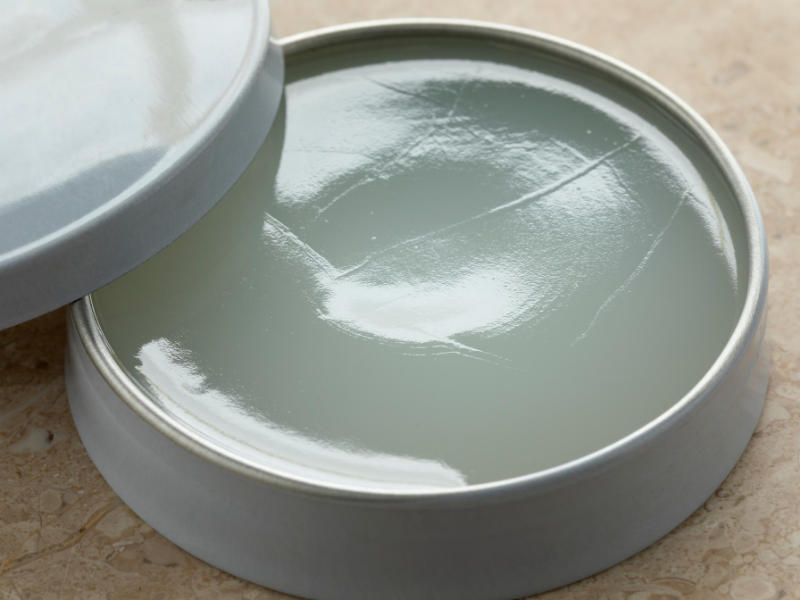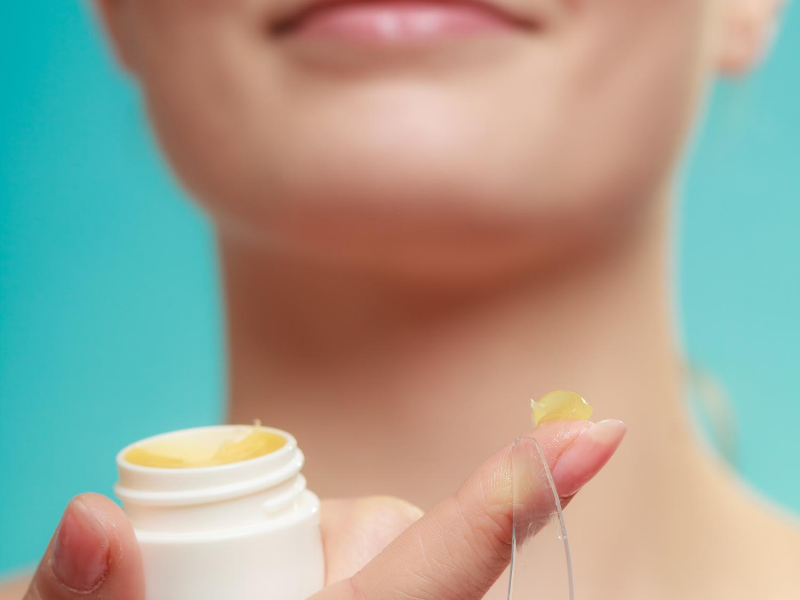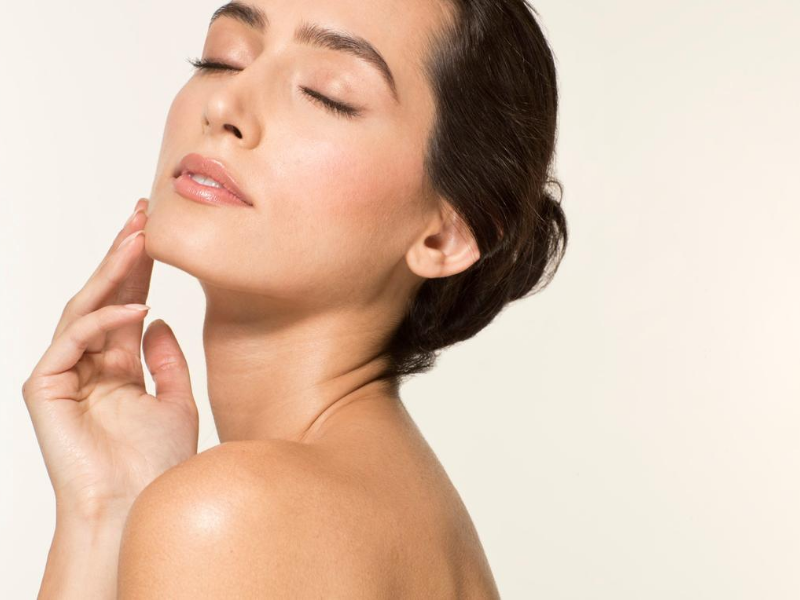Vaseline for your face: is it an old-school remedy or a modern method of moisturizing? The answer is both — kind of.
While many people think Vaseline is non-comedogenic, I have personally seen it be the cause of occluded pores in my dermatology practice. For this reason, I only recommend using it in a few circumstances and only on areas less prone to breakouts.
Vaseline® jelly has been around since 1865, used for everything from chapped lips to piercing aftercare. However, don’t let its age fool you — it has some timeless benefits.
How Vaseline Works with Your Skin
Vaseline jelly works with your skin by creating a protective barrier. This sealing effect not only keeps moisture in, but also defends from further drying and protects your skin from any irritants.
Petroleum jelly started in its rawest form as a byproduct found on oil rigs. While the slippery substance made work harder, the men on the rigs quickly noticed its healing, skin-protecting powers.
Vaseline is not the only form of petroleum jelly, a smooth-spreading mixture made up of waxes and minerals, but it has been triple-purified. This makes a thin layer of Vaseline safe, in most cases, as a skin moisturizer.
Vaseline branded products also contain a variety of lotions, oils, and creams that contain other additives etc. The pure vaseline petroleum jelly without any additives is what we will be referencing in this article.
And for those of you who prefer to use petroleum free products, keep reading as those products also function similarly to vaseline and have some of the pros and cons and caveats as vaseline based products.
Benefits of Using Vaseline
Is it ok to put Vaseline on your face? No, it is usually not ok to put Vaseline on your face, because it can clog pores and oil glands, and even trap oil on skin. There may be some exceptions however — in cases of severely dry skin or for barrier protection from irritants.
Which Vaseline is best for your face? Vaseline Healing Jelly is a great place to start for dry skin, but I usually recommend it more for hands and feet. These areas have less oil glands, and therefore less of a risk of breakout. It can also work to treat chafing on dryer areas of the body.
Moisture
Many products are touted to “lock in moisture,” but Vaseline is one of the most effective methods to prevent your skin’s natural moisture from escaping. One study showed that lanolin and mineral oil only lock in 20-30% of moisture in the skin. However, the same study found that Vaseline can retain up to 98%.
On Top of Eczema Medication
Putting Vaseline on top of eczema medication can make eczema treatments even more effective. The shield-like qualities of petrolatum can keep medication on the skin while preventing moisture loss.
It’s also hypoallergenic, which means it won’t make itchy patches worse.
Makeup Removal
If you’ve run out of your usual means of removing your face makeup, Vaseline is safe to use even around your eyes. Plus, its oily nature helps it cling to and remove mascara easily. Just make sure you wash your face thoroughly after using.
A bonus feature is that the sealing properties of Vaseline can lock in moisture around your eyes, a key component to fighting aging. As we age, we need to nourish our delicate skin near the eyes more than ever.
Healing Scrapes
That barrier function that’s built into petroleum jelly? It’s an added layer of protection from bacteria, which prevents infection and helps seal off the wound to heal.
It is also the most commonly recommended wound care option for skin biopsies and post-operative wound care. Research has shown that vaseline based products result in improved healing with less irritation and risk of allergic contact dermatitis compared to using antibiotic based ointments such as polysporin.
Protecting Chapped Lips
Due to a lack of flavoring and coloring, Vaseline jelly is a non-irritating way to keep your lips looking glossy while helping them heal. Chapped lips are some of the most painful and annoying facial issues during the colder months and using Vaseline could not only heal but prevent this issue.
Aging
Many anti-aging products boast peptides as the main ingredient in their formula. Research indicates that Vaseline (petrolatum) increases peptide production on the surface of the skin.
Yes, this research surprised me too! Aging is complex and of course I’d recommend focusing on an inside & out approach to enhance the anti-aging benefits of any moisturizer.
Skin Conditions & Vaseline: Safe or Not Recommended?
Each body is different, and the skin is your largest organ. Before you dive into using Vaseline, take a moment to see how it may interact with your skin condition, to be sure it’s safe, and recommended.
Psoriasis
If you have psoriasis, you know that moisture is your best friend. While Vaseline isn’t exactly medicated, it can lock in the moisture on your skin or provide protection against flare-ups. Since there are no scents or dyes, it’s usually a safe bet.
Rosacea
The seal that a layer of Vaseline can create acts as a barrier that helps to protect red, inflamed patches of skin. This may be helpful in treating rosacea, though further research is needed.
And I would not recommend using vaseline if you get pimples or pustules with your rosacea breakouts as it will likely worsen them.
Acne
At this point, you may be thinking that this product can do anything, but acne causes real issues with using Vaseline on the face. The barrier it forms can be problematic, locking oils in as well as moisture.
One of the worst things you can do for acne is keep excess sebum trapped on top of your skin! If you struggle with acne, do not use Vaseline on your face.
Skin Types with Vaseline
As a dermatologist, I know that every face interacts with products differently. Vaseline is no exception.
Here’s how each skin type works with Vaseline:
- Oily skin: proceed with caution. It’s easy to overdo it with oily skin and Vaseline, locking in sebum and creating pimples galore. Try to stick to the body instead of the face, and focus on very dry parts (like the feet).
- Dry skin: Vaseline was practically made for dry skin — its protective properties mixed with the way it locks in moisture can relieve discomfort from dry skin.
- Sensitive skin: since Vaseline is unscented, hypoallergenic, and free from artificial coloring, it shouldn’t irritate sensitive skin. However, you can always try a patch test. If petroleum products bother you, try an alternative moisturizer below. Be sure to keep it away from the face!
How to Use Vaseline on the Face
Using Vaseline on your face is not usually advisable, but here’s how to use it on dry areas with fewer oil glands. Generally, a thin layer should suffice. Since Vaseline creates a protective barrier, it will never fully sink in.
Its function is to assist your skin in providing an occlusive barrier. Therefore, no need to slather it onto the skin.
For extremely dry skin, you can apply it on top of other products, like lotion or treatments, to lock them into the skin for optimal absorption.
Dangers of Using Vaseline on Your Face
Vaseline is occlusive. Its primary function is not to add moisture, but rather to form a protective seal around moisture already on your skin. While there are many benefits of using Vaseline on your face, it can easily lock in oil due to its occlusive properties.
Does Vaseline clog your pores? Vaseline can clog your pores and oil glands, locking in sebum and causing folliculitis or acne. While Vaseline has many good uses, using it on oily areas or the face can cause major issues.
I recommend using it on lips or particularly dry areas, but you can’t go wrong sticking to patches like the elbows, knees, and tops of the hands and feet. The dry, thinner skin in these parts of the body is not prone to these sorts of breakouts.
Also, while Vaseline locks in moisture, this same occlusive effect can lock in heat. To avoid worsening burns, don’t apply it after sunbathing or after burning yourself.
Does Vaseline darken skin? Vaseline does not darken skin, contrary to rumors. However, if you’re concerned about dark spots, Vaseline has a range of lightening lotions.
Recommended Brands
While Vaseline is a good choice, here are some others you could try instead of Vaseline on the face:
- White Rose: this 100% petrolatum is another option for pure petroleum jelly.
- Dax Purest White: this is another 100% petrolatum option, with no additives.
When purchasing a petroleum jelly for facial use, be sure it is 100% petroleum jelly with no fillers or additives, and that it has been purified. It did originate on oil rigs, after all!
Alternative Moisturizers
If you don’t feel Vaseline works with your skin or you avoid products made with petroleum, there are a few options to try instead.
Aquaphor starts with petroleum jelly, but adds other ingredients like glycerin and mineral oil for a different texture.
This differs from Vaseline, which is only made up of petrolatum. Aquaphor actively moisturizes with additional ingredients, while Vaseline retains existing moisture.
Emollients and humectants can also be a good source of moisture for the skin, while providing slightly different scientific functions. I’m also a fan of natural oils for the skin.
Un-petroleum Jelly by Alba is a good alternative for those who don’t want to use petroleum products. However, it is still occlusive, so the same risks apply in terms of potentially trapping sebum or dirt on top of the skin.
No matter what petroleum jelly (or even an alternative) that you choose, you can speed up moisturizing and healing needy skin with one of these occlusive agents. Just be sure to keep in mind your skin type, any skin conditions, and to use a light touch.
Sources
- Sethi, A., Kaur, T., Malhotra, S. K., & Gambhir, M. L. (2016). Moisturizers: the slippery road. Indian journal of dermatology, 61(3), 279. Full article: https://www.ncbi.nlm.nih.gov/pmc/articles/PMC4885180/
- Czarnowicki, T., Malajian, D., Khattri, S., da Rosa, J. C., Dutt, R., Finney, R., … & Zheng, X. (2016). Petrolatum: barrier repair and antimicrobial responses underlying this “inert” moisturizer. Journal of Allergy and Clinical Immunology, 137(4), 1091-1102. Abstract: https://pubmed.ncbi.nlm.nih.gov/26431582/
- Gonçalves, M. M. B. D. M. M., & Pina, M. E. S. R. T. D. (2017). Dermocosmetic care for rosacea. Brazilian Journal of Pharmaceutical Sciences, 53(4). Full text: https://www.scielo.br/scielo.php?script=sci_arttext&pid=S1984-82502017000400401
- Chularojanamontri, L., Tuchinda, P., Kulthanan, K., & Pongparit, K. (2014). Moisturizers for acne: What are their constituents?. The Journal of clinical and aesthetic dermatology, 7(5), 36. Full text: https://www.ncbi.nlm.nih.gov/pmc/articles/PMC4025519/
- De Souza, B. A., Furniss, D., Olaofe, G., & Jawad, M. (2003). Vaseline should not be used as first aid for burns. Bmj, 327(7426), 1289. Full text: https://www.ncbi.nlm.nih.gov/pmc/articles/PMC286261/





